

In order to understand the connection between TMJ and Body Posture, you have to note that no body part is independent from the other body parts.
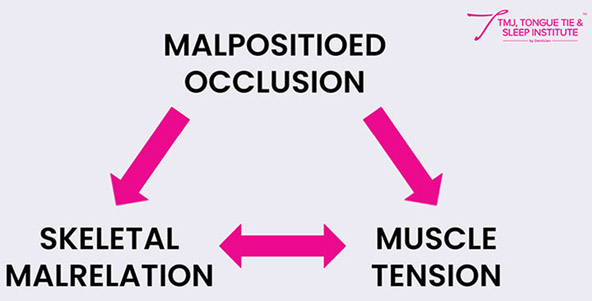
For our body to function properly, all the body parts should work in conjunction with each other. While diagnosing dental issues, especially when evaluating your bite or TMJ joint, it is necessary to check your body posture. It is essential because misaligned jaw joints or teeth can cause postural imbalance, and you should take prompt action to treat the condition.
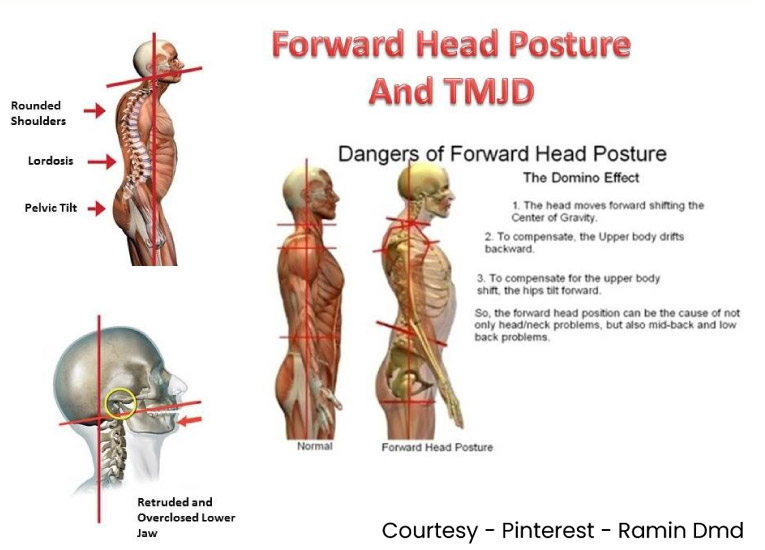
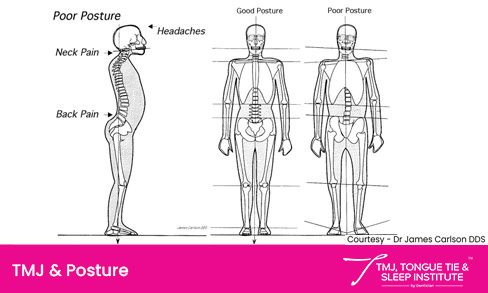
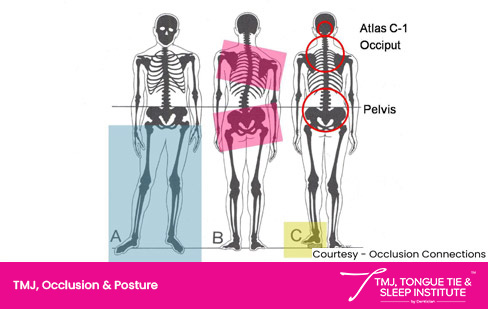
One of the treatments for correcting short leg syndrome caused due to TMD is by placing a GNM Orthotic to align your jaws which will in turn levels the shoulders and pelvis to put the feet in their natural position.
You must have noticed a pattern of how the imbalance starts at the top of your body and moves downwards, reverberating through the entire body, this is known as descending TMJ. Refer to our orofacial pain relief guide to learn more about descending TMJ.
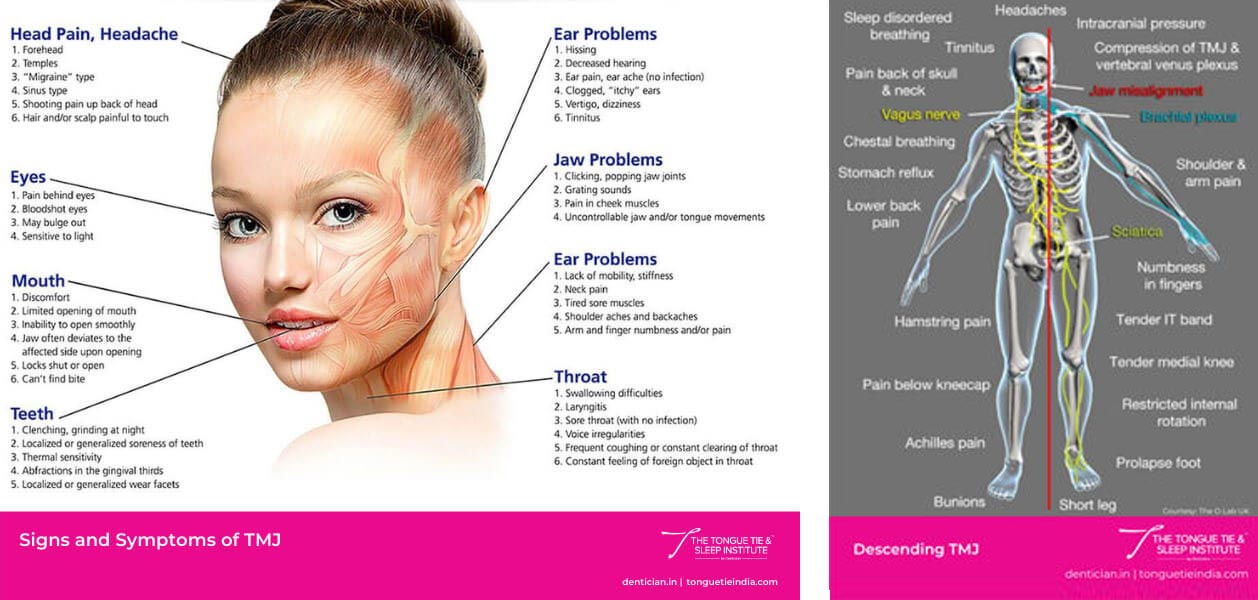
Other common symptoms that occur due to the imbalance between bite and mandibular position include leg cramps, knee pain, sciatica, mid-back pain, and neck tension.
For a better understanding of the headaches, migraines, and TMJ disorder, you can refer to our informative guide about TMJ disorder.
While bad posture does not directly cause a TMJ Disorder, it is a contributing factor. A bad posture can cause your head and neck to move in a forward position, which can affect your bite and temporomandibular joint, causing alignment problems and vice versa.
Due to the lack of awareness about TMJ Disorder, TMD patients are often misdiagnosed and do not receive proper treatment. Instead, when faced with patients who exhibit symptoms such as pain in the ear, feeling pressure in the ears, and ringing in the ear, all focused on one body part, the clinicians offer treatment based on the location of pain or symptoms. This often causes the patients to wander from specialist to specialist until they find a TMJ expert who’ll offer treatment for the same.
GNM, also known as Gnathic Neuromuscular Dentistry, is an advanced approach focusing on correcting TMJ pain, jaw alignment, body alignment and malocclusion to ensure optimal lower jaw and full body form and function.
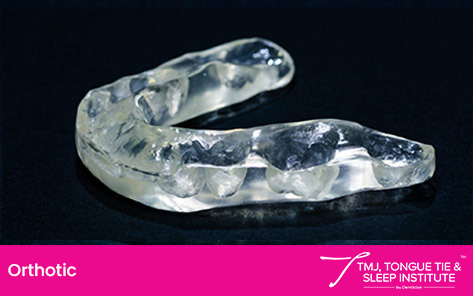
The appliances used as GNM orthotics for TMJ may look like any other TMJ Splints or TMJ mouthguards. But it implements both gnathologic and neuromuscular principles. The GNM approach and orthotic design cannot be compared by merely looking at the external (visual) features as there are other factors such as its physiologic inherent components that support optimal muscle balance, TM joint harmony, occlusal harmony and many other functional features that move physical dysfunctions to physiologic quality health and shifts functional impairments to an improved quality of life.
GNM orthotics can solve issues such as TM joint derangement, crossbite, anterior open bite, facial pain, headaches, pain experienced at the back of the head, shoulder tension, restricted head rotation, restricted mouth opening, one-sided deviation of the jaw, and clicking and popping in jaw joints and sleep apnea.
Patients interested in non-invasive methods of treating TMJ can look into Myofunctional therapy. Myofunctional therapy is a non-invasive method that can help patients by strengthening orofacial and tongue muscles. This helps stabilize your jaw and TMJ. It does a great job of relieving muscle tension.
A chiropractor is a healthcare provider similar to a physiotherapist that diagnoses & treats a patient’s bony & musculoskeletal problems.
For example,
If the patient is facing postural challenges such as upward head tilt posture, lower back pain or abnormal pelvic problem they’ll need to visit a qualified chiropractor.
A TMJ doctor and chiropractor can work together and rule out these factors. We encourage you to visit the TMJ, Tongue Tie and Sleep Institute in Mumbai, where you can get an accurate diagnosis and treatment for your TMJ disorder.
Copyright ©2025 TMJ, Tongue Tie and Sleep Institute. All Rights Reserved.
WhatsApp us
Let Us Know How Can We Help You!
At our institute, we take pride in providing complete care for issues related to tongue tie and TMJ. To enhance your quality of life, we treat a range of ailments with state-of-the-art technology and expert care. If you’re searching for an effective tongue-tie operation option or a TMJ specialist in India, you have arrived at the right place.
A tongue tie operation or tongue tie surgery is a life-changing procedure that not only restores tongue mobility but also has a full body effect. While most people associate tongue tie with breastfeeding difficulties in infants, it can also affect speech, breathing, posture, dental health, and sleep patterns in older children and adults. By undergoing this minimally invasive fascia release procedure, patients often experience immediate improvements in functionality and overall well-being.
For individuals considering tongue tie surgery, the benefits are far-reaching:
The Temporomandibular Joint (TMJ) that is your Jaw Joint has a significant impact on one’s quality of life, as they leave the person feeling exhausted and irritable. It not only affects essential functions like chewing, speaking, yawning but also affects one’s posture, breathing and sleep. As a leading TMJ specialist in Mumbai, we offer comprehensive diagnostics and personalized treatment plans to address your unique needs.
An integral part of our treatment protocols is myofunctional therapy. Exercises used in this therapy help to strengthen and coordinate the muscles of the tongue and face. Whether you’re undergoing a tongue tie operation or being treated for TMJ issues, myofunctional therapy plays a pivotal role in ensuring lasting outcomes.
Expertise and complete treatment are essential for treating TMJ issues or tongue tie. Whether you’re searching for the best tongue tie surgery options or a trusted TMJ specialist in Mumbai, we ensure personalized care and transformative results. Don’t let these conditions stop you—reach out to us today to book your consultation and start your journey toward better health and wellness.